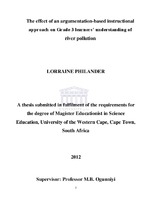| dc.contributor.advisor | Ogunniyi, Meshach B. | |
| dc.contributor.author | Hlazo, Noluthando | |
| dc.date.accessioned | 2015-02-26T08:55:20Z | |
| dc.date.available | 2015-02-26T08:55:20Z | |
| dc.date.issued | 2014 | |
| dc.identifier.uri | http://hdl.handle.net/11394/4000 | |
| dc.description | Magister Educationis - MEd | en_US |
| dc.description.abstract | The study employed a quasi-experimental design to determine the effect of DAIM on learners’ conceptions of lightning. The experimental group was taught using DAIM while the control group was taught the same content using TLM. Data was collected using the Science Attitude Questionnaire (SAQ), Beliefs about Lightning Questionnaire (BALQ), Conceptions of Lightning Questionnaire (COLQ) and Science Achievement Test on Lightning (SATOL) which was used to determine learners’ overall performance on the topic of electrostatics. The data was analysed using both qualitative and quantitative methods. The findings of the study revealed that prior to the intervention (DAIM); the two groups of learners had both the scientific and the indigenous knowledge about lightning. A majority of the learners believed that lightning is caused by witches and traditional doctors. After being exposed to the DAIM most of the learners in the experimental group were found to have changed to the more scientific explanation of cause of lightning and protective measures against lightning. Few learners in the control were classified as possessing an equipollent worldview in terms of the CAT after the post tests. Some learners’ conceptions about lightning wavered between the scientific and traditional worldviews. The Science Attitude Questionnaire showed that both groups of learners had a positive attitude towards science. The findings also suggested that the inclusion of indigenous knowledge in science lessons promoted active participation from the learners, reinforced the learning of science because it promoted conceptual development and scientific literacy. The learners in the study also supported the integration of the scientific and the traditional worldviews about lightning. After the instruction, the learners in both groups seemed to still hold indigenous beliefs in relation to lightning. The post-test results showed that the DAIM group seemed to have been able to link the concept of lightning with electrostatics when they related lightning storms to electric discharge. The experimental group was found to be more elaborate in their explanations of the scientific nature of lightning than the control group which was not exposed to DAIM | en_US |
| dc.language.iso | en | en_US |
| dc.publisher | University of the Western Cape | en_US |
| dc.subject | Toulmin’s argumentation pattern | en_US |
| dc.subject | Contiguity argumentation theory | en_US |
| dc.subject | Border crossing | en_US |
| dc.subject | Socio-cultural constructiviscm | en_US |
| dc.subject | Dialogical argumentation | en_US |
| dc.subject | Dialogical argumentation instructional model | en_US |
| dc.subject | Conceptual change | en_US |
| dc.subject | Indigenous beliefs | en_US |
| dc.subject | Quasi experimental design | en_US |
| dc.subject | Conceptions about lightning | en_US |
| dc.title | Effects of a dialogical argumentation instructional model on grade 10 learners’ conceptions of lightning | en_US |
| dc.type | Thesis | en_US |
| dc.rights.holder | University of the Western Cape | en_US |




